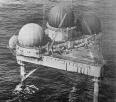Texas Tower #4
 In 1959, Texas Tower #4, located approximately 75 miles due east of Barnegat Inlet in New Jersey, and 58 miles out of Fire Island Inlet in New York, was one of three offshore radar installations (#1 was never built) intended to provide advance warning of enemy air attacks, all part of the Distant Early Warning system (DEW line) encircling the United States and Canada. This technology is not used today, as it was quickly made obsolete by newer airborne radars. The "Texas Tower" nickname came from the platforms' resemblance to offshore oil rigs in the Gulf of Mexico.
In 1959, Texas Tower #4, located approximately 75 miles due east of Barnegat Inlet in New Jersey, and 58 miles out of Fire Island Inlet in New York, was one of three offshore radar installations (#1 was never built) intended to provide advance warning of enemy air attacks, all part of the Distant Early Warning system (DEW line) encircling the United States and Canada. This technology is not used today, as it was quickly made obsolete by newer airborne radars. The "Texas Tower" nickname came from the platforms' resemblance to offshore oil rigs in the Gulf of Mexico. The first two towers, off of Nantucket and Boston, were driven into a rocky ocean bottom in relatively shallow water (50 and 80 foot depths). TT #4, however, was more of a challenge. It would stand in 180 feet of water, and rise nearly 70 feet above the surface. The triangular platform measured 187 feet per side, and the structure weighed 3,200 tons. Each leg was 300 feet long, 12.5 feet in diameter, and weighed 450 tons. TT #4 was considered an "engineering triumph" when it was floated into position in the summer of 1957, and was built to withstand winds up to 125 mph and waves up to 60 feet high. This design was thought sufficient to get the tower through any storm known.
The battering delivered by storms combined with the soft mud and sand that formed the foundation for the Tower's legs, however, soon began to take their toll. Repairs were made after each of the two hurricanes that hit the Tower, but its stability continued to decline, and TT #4 soon earned the nickname "Old Shaky". Most of the 70-man Air Force crew was evacuated near the end of 1960, but a skeleton crew of 28 men (14 airmen and 14 civilian repairmen) remained through the winter, despite the urging of the Tower's commander that they all be evacuated until repairs could be completed in the spring. In January of 1961, yet another storm struck the tower. Rescue ships were dispatched, but were too late. On January 15, less than four years after it began operation, Texas Tower #4 disappeared from a rescue ship's radar screen and collapsed into the sea, killing all aboard. The immediate rescue mission, which evolved into a month-long recovery and investigative operation, recovered only two bodies.
Now, the Texas Tower rests at a 45-degree angle in about 200 feet of water, and rises to within 130 feet of the surface. Living and working spaces are inside the triangular platform, and the remains of the three large domes that housed radar equipment rise from the platform surface. Divers investigating the site immediately after the Tower's collapse found that the structure seems to have been wrenched off of two of its supports, floating some 200 yards before settling to the bottom on one edge of the platform, with the third corner held up by the one leg that remained attached.
In the time since the collapse, the radomes have deteriorated, but pieces of the canvas that once covered them still remain draped over the wreckage. A crane gantry lies across the main deck. The radio masts, one of which went down in the initial collapse, are now booth gone. Some structures, such as the radar mounts and crane, remain on the exterior of the structure and are visible without penetration; there are also opportunities for easy penetrations within the natural light zone.
Marine life is abundant, including cod, Pollock, lobster, ling, sea bass, and flounder. Water is usually clear, but strong currents are sometimes a problem, especially near the surface. As the Texas Tower attracts fishermen as well as divers, there is always the danger of fishing nets which have snagged and been left on the wreck.
For more information about the Texas Towers, visit www.radomes.org/museum.
For more South Jersey History, visit our History page.
advertisement

Author: R. Cohen
Archives
Collingswood
A Southern Mansion
Light up the Night
Dining Alfresco
Sink or Swim
Throwing Shade
The Outdoors in Order
The Foundation
A New Spin on Swim
Gloucester Township
Wonderful Water
The Foundation: June, 2015
Community Connection: Moorestown
Things to Do
Cinnaminson
More...







